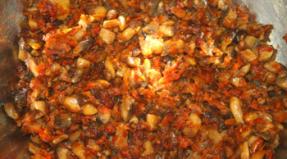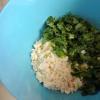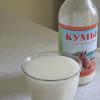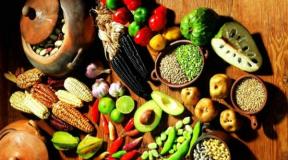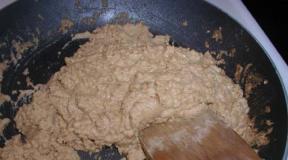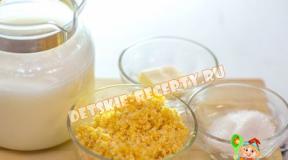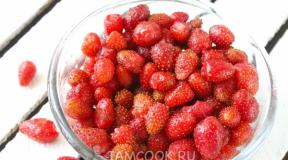Tomato calories in 1 piece. Calorie Tomato (tomato), ground
Tomato is one of the most popular vegetables. It is consumed raw, juices are made from it, and also added to salads, first and second courses, and canned. This vegetable is useful for various diseases, and its taste makes it a welcome guest on every table. This article details the benefits and harms of tomatoes.
Biological description and distribution
Tomato (tomato) - a plant belonging to the species of the genus "Nightshade" of the family "Nightshade". Known as a vegetable crop. The word "tomato" in translation from Italian means "golden apple".
The plant has a very developed root system, which grows and forms extremely quickly. The roots can go into the soil to a depth of 1 meter or more and form on any part of the stem. This makes it possible to propagate the tomato not only by seeds, but also by stepchildren, cuttings.
The stem of the tomato is decumbent or erect, reaching a height of up to 2 meters or more, and the leaves are dissected into large lobes, pinnate. The plant has small and unremarkable yellow flowers, collected in a brush.
The fruits of the vegetable are of different shapes. They can be small, medium and large. Color of fruits from pink to raspberry, from white to golden yellow.
The plant is thermophilic. It is best to grow it at a temperature of 22-25 ° C. Vegetable culture has a negative attitude to high humidity, but responds responsively to abundant watering. For growth and development, it needs good lighting and additional illumination during the seedling period.
The tomato is native to South America. On this mainland, its semi-cultivated and wild forms grow to this day.
In a work called "The General History of the Affairs of New Spain" (1547-1577), there is an earlier mention of a tomato. Bernardino de Sahagún described the healing properties of this plant, based on the data of the Aztecs (the treatment of eye disease in adults and the common cold in newborns).
In the middle of the 16th century (already then a lot was known about the benefits and harms of vegetables) the tomato was brought to Spain and Portugal. From there he went to Italy, France and other European countries. The first recipe using this plant was published in a 1692 cookbook.
In the 18th century, tomato began to be cultivated in Russia as an ornamental plant. Soon it received the status of a food crop thanks to the efforts of the scientist A. T. Bolotov.
For a long time, the vegetable was considered unfit for human consumption and even poisonous. An American textbook even described a case where one of the cooks tried to poison George Washington with a tomato.
Composition and calorie content of tomato
calories: per 100 gr. Tomato accounts for about 19 kcal.
Nutritional value (per 100 g of product):
- fats - 4%;
- proteins - 17.7%;
- carbohydrates - 78.3%.
The plant contains: sugars, organic acids, proteins, fiber, starch, pectin and minerals. In the ashes of tomatoes found: salts of potassium, sodium, phosphorus, iron, magnesium, minerals (sulfur, silicon, iodine, vanadium, zinc, cobalt, chlorine and others).
The fruits are rich in carotenoids, vitamins, C, folic, organic, high molecular weight fatty and phenol carboxylic acids. This part of the plant contains anthocyanins, triterpene saponins, stearins, abscisic acid.
Tomato is famous for its dietary, nutritional, taste, and beneficial properties. Choline, which is part of it, lowers the amount of cholesterol in the blood, strengthens the immune system, prevents fatty changes in the liver and promotes the production of hemoglobin.
Due to all of the listed rich composition - a tomato is considered a very useful vegetable (read below about the dangers)
The use of tomatoes
In cooking.
The tomato is one of the popular vegetables grown every year. Gardeners appreciate it for the variety of varieties and responsiveness to the applied agricultural technology. The plant is cultivated on plots, as well as at home.
Tomato fruits are consumed fresh, fried, boiled and canned. They are used to make mashed potatoes, pasta, juice, ketchup, lecho and other sauces. In Spain, cold vegetable dishes are popular - gazpacho, salmorejo.
Dried tomatoes are rich in lycopene and other beneficial substances, so they are often added to soups. When dried in the sun, fresh tomatoes lose most of their weight. To obtain 1 kg of dry mix, 8 to 14 kg of fruits are needed.
In medicine.
Tomatoes are used fresh for the preparation of medicinal mixtures. For medicinal purposes, use tomato juice.
The benefits and harms of tomatoes
Beneficial features:
- The composition of the fruit includes a huge amount of vitamins, minerals and nutrients that positively affect the functioning of the body. This vegetable is rich in fiber - dietary fiber, which significantly improves bowel function and helps cleanse it.
- Tomato is known as a diuretic. It is useful for people suffering from diseases of the kidneys and bladder.
- The fruits of the plant contain B vitamins, calcium and potassium. Including it in the diet helps to strengthen blood vessels and the heart, lower blood pressure, improve the condition of the skin, hair and nails.
- Tomato is a dietary product. After its use, there is a feeling of satiety.
- The composition of the fruit includes iron - a trace element necessary for normal hematopoiesis and transport of oxygen to blood cells. It is useful to eat a vegetable to strengthen the nervous system, eliminate the effects of stress, improve sleep, as it is rich in magnesium.
- According to research results, tomatoes are shown to people suffering from a bad mood. Regular consumption of these vegetables improves mood and reduces fatigue.
- Tomatoes are rich in phytoncides - substances with antibacterial and anti-inflammatory properties.
Tomato is contraindicated in the following diseases:
- Gastric ulcer.
- Gastritis with high acidity.
- Acute pancreatitis.
- Heartburn.
It is not advisable to abuse tomatoes for gout, kidney disease and arthritis, as they contain oxalic acid and purines (in small quantities) - substances that negatively affect salt metabolism.
Useful components that make up the tomato, after heat treatment, turn into inorganic compounds that are harmful to humans. Therefore, you should not abuse boiled and canned fruits, as well as their juices (especially those containing starch and sugar), as this is fraught with the formation of stones in the bladder and kidneys.
The following technique will help to avoid heartburn, pain, bloating and nausea in chronic gastrointestinal diseases: before eating tomatoes, you need to dip them in boiling water for 20 seconds, pour over with cold water, and then free them from the skin. In the same way, fruits can be processed to prevent spasms of the gallbladder that occur with gallstone disease.
Useful properties and contraindications to the use of tomato juice
Beneficial features:
200 ml of tomato juice contains 1 ml of carotene, a substance that is converted into vitamin A in the body. People who regularly drink this drink during warm seasons feel better in winter and autumn than those who do not.
There is a test that allows you to determine whether the body has enough vitamin A. You need to stay in the light, and then go to a dark room. If the eyes become accustomed to the dark in more than 6 seconds, then the person should increase their intake of foods rich in vitamin A.
The inclusion of tomato juice in the diet helps to get rid of excess weight. It is useful to take 1 glass of this drink after 40 years to strengthen the cardiovascular system and prevent atherosclerosis. Vegetable juice is indicated for hypertensive patients, as well as for those who are sick with anemia and angina pectoris.
Drinking a healing drink is useful for diabetes, as it helps to reduce blood sugar. You can drink tomato juice to improve memory, as well as reduce eye pressure, for example, with glaucoma. It is desirable to take it with gastritis with low acidity, after myocardial infarction and with certain forms of nephrolithiasis.
Studies have shown that the constant use of tomato juice prevents thrombosis of the veins in the legs. This disease affects people who practice a sedentary lifestyle.
This drink is effective in combating chronic fatigue and stress. Experts conducted a survey among people of various professions and ages to identify their diet. More than 200 respondents participated in the survey, of which only 35% used tomato juice from time to time. Scientists have associated with such indicators of nervousness, so common among the population. It has been proven that taking a healing drink contributes to the production of serotonin, also called the "hormone of joy." It is he who is responsible for relieving fatigue and overcoming the effects of stress.
Tomato juice contains lycopene, a substance that gives the drink a red color and also destroys free radicals in the human body. This explains the fact that drinking a drink made from fresh fruits prevents cancer.
Tomato juice is an effective remedy for constipation. It suppresses putrefactive phenomena in the intestines and improves the functioning of this organ. In addition, the healing drink is famous for its antibacterial and anti-inflammatory properties.
Contraindications to the use of tomato juice:
- Stones in the kidneys or bladder (to avoid pain).
- Gastritis with high acidity, peptic ulcer, cholecystitis, pancreatitis.
- Children's age up to 6 months (can be given to one-year-old babies, after diluting the drink with water).
Not recommended combine tomato juice with starchy foods, as this can lead to the appearance of stones in the bladder, kidneys. A freshly squeezed drink, consumed in large quantities, can cause severe indigestion.
How to prepare tomato juice

tomato juice: benefits and harms
For medicinal purposes, it is best to use juice prepared at home. It contains more nutrients than store-bought. In addition, you can be 100% sure as a homemade drink.
If you use a juicer, the pulp of the vegetable will remain in it, as a result of which most of the valuable compounds will be lost. That is why it is advisable to prepare juice using a meat grinder, food processor or blender.
Before you make a drink, tomatoes must be peeled. To do this, you need to immerse them for a few seconds in boiling water, and then abruptly pour cold water over them. You can get rid of the seeds by straining the juice through a thick cheesecloth.
Unripe tomatoes contain the poisonous substance solanine, so only ripe fruits can be used for cooking. Ready juice can be seasoned with finely chopped dill or parsley. The use of salt and pepper will compromise the beneficial properties of the drink.
The benefits and harms of cherry tomatoes:
Benefit:
- The composition of the fruit includes lycopene - a substance that reduces the likelihood of developing ailments of the cardiovascular system, cancer of the esophagus, stomach and lungs. Lycopene is a fat-soluble compound, so it is advisable to season tomatoes with sour cream or vegetable oil.
- Cherries are rich in vitamin K, necessary for the absorption of calcium and the normal functioning of the kidneys.
- Eating small tomatoes helps to improve mood and quickly get rid of hunger. They are recommended to eat with a breakdown, ailments of the cardiovascular system, diseases of the gastrointestinal tract, anemia.
Cherry tomatoes are contraindicated in the following diseases:
- Peptic ulcer (the maximum daily number of fruits should not exceed 100 g).
- Individual intolerance to the product.
- Metabolic disorders.
- Cholelithiasis.
Folk recipes
- When coughing.
Grind 900 g of fresh tomatoes with a meat grinder, add 1 head of garlic and 100 g of horseradish roots. Mix all ingredients. Take 20 g of the drug 3 times a day for 1/3 hour before meals. Store folk medicine in the refrigerator.
- With atherosclerosis, anemia, obesity.
Take tomato juice in an amount of 150 ml 3 times a day 1/4 hour before meals.
Eat vegetable salads, which include 200-300 g of fresh tomatoes.
- With constipation.
Take 1 glass of tomato juice 1-2 times a day 1/3 hour before meals. The treatment course is 2-3 weeks.
- In violation of metabolism.
Grind 5 cloves of garlic and 900 g of fresh tomatoes with a meat grinder. Add to the ingredients: 300 g of sour apples, 100 gr. crushed pepper (sweet). Mix all components. Take 2 tbsp. l. funds 1/3 hour before meals 3 times a day.
- With liver diseases.
Pour 30 ml of honey into 200 g of freshly squeezed tomato juice. Mix all ingredients. Means to take in the amount of 100 ml. 3 times a day.
In equal proportions, mix the brine of tomato juice and sauerkraut (100 ml each). Take 1/3 cup after meals 3 times a day.
- When you lose strength.
Drink 200 ml of freshly squeezed juice mixed with 10 g of chopped dill and parsley for breakfast.
- For rough skin.
Make compresses from vegetable pulp on problem areas.
- With acne, pigmentation.
Wipe the skin with a slice of fresh tomato.
- With varicose veins.
Apply gruel prepared from fresh tomatoes to the affected areas. Remove the product after it pinches the skin and apply sour cream on it, moving in the direction from the foot up.
- With purulent wounds, boils, erysipelas, bedsores and eczema.
Apply fresh fruit pulp to damaged areas 2-3 times a day.
- From scabies.
Sauté 2 parts fresh tomatoes in 1 part oil. Apply oil to the affected areas 1-2 times a day.
- Question: Is a tomato a fruit, vegetable or berry? has been the subject of much scientific debate. Botanically, this plant is a berry. The English do not distinguish between the concepts of "fruit" and "fruit". At the end of the 19th century, the US Supreme Court, for the correct collection of customs duties, recognized that tomatoes are vegetables, and in 2001, members of the European Union decided that tomatoes should be considered fruits.
- In Kamenka, a monument called "Glory to the Tomato" was erected.
- A tomato is 90% water. Much more .
You can talk endlessly about the beneficial properties of a tomato. This vegetable is extremely rich in iron, famous for its nutritional, taste and dietary qualities. In moderation (in the absence of contraindications), its use will only benefit.
Tomato (tomato), ground rich in vitamins and minerals such as: vitamin A - 14.8%, beta-carotene - 16%, vitamin C - 27.8%, potassium - 11.6%, silicon - 20%, cobalt - 60%, copper - eleven %
What is useful Tomato (tomato), ground
- Vitamin A is responsible for normal development, reproductive function, skin and eye health, and maintaining immunity.
- B-carotene is a provitamin A and has antioxidant properties. 6 micrograms of beta-carotene is equivalent to 1 microgram of vitamin A.
- Vitamin C participates in redox reactions, the functioning of the immune system, promotes the absorption of iron. Deficiency leads to friable and bleeding gums, nosebleeds due to increased permeability and fragility of blood capillaries.
- Potassium is the main intracellular ion involved in the regulation of water, acid and electrolyte balance, is involved in the processes of nerve impulses, pressure regulation.
- Silicon is included as a structural component in the composition of glycosaminoglycans and stimulates the synthesis of collagen.
- Cobalt is part of vitamin B12. Activates the enzymes of fatty acid metabolism and folic acid metabolism.
- Copper is part of the enzymes that have redox activity and are involved in the metabolism of iron, stimulates the absorption of proteins and carbohydrates. Participates in the processes of providing tissues of the human body with oxygen. Deficiency is manifested by violations of the formation of the cardiovascular system and skeleton, the development of connective tissue dysplasia.
A complete guide to the most useful products you can see in the application
Tomatoes appeared in Russia relatively recently, at the beginning of the 19th century, and in this short time they have become the most beloved vegetable. Every home prepares dishes with tomatoes. For those who follow their figure, their calorie content is important. Is it possible to eat tomatoes without fear of gaining extra pounds? How many calories are in 100 g of product? What are the health benefits of this vegetable? We will answer these and other questions in this article.
Tomato is an important and valuable food product
It contains other vitamins and other substances we need:
- Carotene. Good for eyesight.
- Antioxidants that protect a person from cancer.
- Phytoncides do not allow pathogenic microorganisms to multiply.
- Zinc helps to relieve inflammation on the skin, recover from acne.
- Tomatoes contain vitamins K, E, C, PP and group B.
- Tomatoes are rich in folic acid and lycopene, which protect the human heart.
- Thiamine helps to be more cheerful and more cheerful, to fight viruses more successfully.
- Tomatoes are high in carbohydrates. 100 grams of the product contains 3.8 g of carbohydrates, 1.1 g of protein and only 0.2 g of fat.

The composition of tomatoes and calories
What is useful
But these are not all the useful properties of tomatoes. They heal the gastric mucosa, which suffers from gastritis. Tomato peel cleans the intestinal walls from food debris.
These properties of the brush are good for the gastrointestinal tract, which absorbs nutrients better after brushing.
Due to the fact that tomatoes contain a lot of B and C vitamins, they can restore metabolic processes in the body. These metabolism-boosting properties make tomatoes a mainstay of diets for those looking to lose weight.
But for those who suffer from hypertension, gout and cholelithiasis, it is better not to eat tomatoes.
calories
The beneficial properties of vegetables and fruits have been known for a long time. But some of them doctors advise to use in moderation, because. they are too high in calories. How many calories are in a tomato? Scientists say that the calorie content of this vegetable is low.

Tomato juice has a minimum of calories, but satisfies hunger and thirst
fresh tomatoes
It is impossible to say exactly how many calories 100 grams of fresh tomatoes contain. Much depends on the particular variety. Nutritionists say that 100 g of fresh product contains about 20 kcal. Their nutritional value is not great, because. they are 94% water. If you eat a large tomato, you will get 45 kcal, a small one - 10 kcal. Often we make a salad of fresh tomatoes with vegetable oil. Then you will get almost 2 times more calories, because. 100 g of such a salad is 45 kcal. But still, the calorie content is low.

Fresh tomato salad - one of the most delicious dishes
If you want to lose weight, eat tomatoes without salt. The nutritional value of this does not change, as well as its properties.
But, getting into the stomach, this sour and at the same time salty food irritates its walls, because of which the appetite may wake up.
There are a huge number of varieties of tomatoes, but cherry tomatoes are worth highlighting. If other varieties differ in fruits of considerable size, that in cherry they are miniature, weighing from 10 to 30 g. Their calorie content is even less. If you take 100 grams of cherry, then they contain from 15 to 20 kcal. 100 grams is about 3-4 of the largest cherry tomatoes. Eating 1 cherry, we get from 3 to 7 kcal. The amount of carbohydrates in them is also significant, per 100 g - 2.8 g. These figures are valid for fresh cherry tomatoes. Marinated are more high-calorie: in 100 g of the product - 18 kcal. Due to the fact that cherry has a low calorie content, they are advised to those who are overweight, diagnosed with obesity. In addition, cherry cheer up, help fight depression.

Cherry tomatoes are so sweet that they are eaten like fruit.
They have a small calorie content, there are not so many carbohydrates, but the composition and properties of tomatoes bring a feeling of satiety.
processed tomatoes
We most often eat fresh tomatoes in the summer, although they can be found on store shelves all year round. In the cold season, pickled tomatoes are taken from the pantries. Their nutritional value is even less, only 15 kcal per 100 grams. Therefore, they will not spoil the figure. Pickled tomatoes using vinegar, salt and sugar, as well as spices. But they can also be salted. But the calorie content will not increase from this. Salted tomatoes contain even fewer calories, only 13 per 100 g. But they are not recommended for people with joint diseases. Pickles contain oxalic acid, so they should not be eaten by people with urolithiasis or gout.

Canned tomatoes - vitamins for the winter
Pickled tomatoes have only 16 calories per 100 g.
The tomatoes themselves are delicious, as are the products made from this vegetable. Do they harm our figure? Very useful and tasty tomato juice. Calories are not a concern. One glass of juice will replenish the daily intake of vitamin C and A. In addition, you should not be afraid that extra pounds will appear because of the juice, because. it is low calorie. There are only 21 kcal in 100 g of juice.
The most high-calorie is ketchup - 112 kcal, although not many are ready to refuse it yet. Much fewer calories are found in tomato paste, only 91 kcal.
As we can see, there are few calories in a tomato, as well as products made from them. Therefore, you can eat them without fear of spoiling the figure. If there are no contraindications, then tomatoes contribute to the healing of the body, supply it with vitamins and essential substances, and they are valued for these beneficial properties.
Tomatoes are indispensable on any table, whether it's a holiday or an everyday lunch. The tomato, which is low in calories and high in taste, is in favor with both lovers of delicious food and those who follow a diet. People are so accustomed to this vegetable that they add it to soups, salads, snacks. And for good reason, because the tomato is not only tasty, but also healthy.
Product calorie content
Tomato is the best friend of losing weight. It can be eaten in large quantities, but not to gain calories. After all, for 100 grams, i.e. for 1 pc. This medium-sized vegetable has only about 20 kcal. Cherry tomatoes have even less calories - 15 kcal. A real paradise for dieters and weight watchers: fresh juice and tomato paste, the calorie content of which is even lower - about 12 kcal per 100 grams.
However, the calorie content depends on the variety of tomatoes. Therefore, it is impossible to say exactly how many calories are in a tomato plucked from a bush. Red fruits in these indicators are the best. They are not only low in calories, but also more useful than, for example, yellow varieties. The calorie content of a fresh tomato with a fleshy content is higher than that of a watery fruit. The figure can reach up to 35 kcal per 100 g.
Tomatoes have a good energy value. Tomatoes contain slow carbohydrates, which are very beneficial for the body. They provide the full absorption of fats and proteins and are the main source of energy. How many carbohydrates in a tomato depends on the variety. On average, their number is 5-6 g per medium-sized fetus.
Beneficial features
In 1 tomato, as in tomato juice, you can find so many vitamins and nutrients that you can’t list everything. The vegetable contains a large amount of fiber, vitamins A and C. Moreover, the latter is located mainly near the seeds. Fresh tomato contains the pigment lycopene, which is not produced by the human body, but is a good tool for the prevention of cancer. In large quantities contain tomatoes and serotonin, known as the hormone of joy. Moreover, heat treatment does not at all reduce the beneficial properties of the vegetable. Eating tomato soup or drinking juice can not only improve your health, but also cheer you up.
Advice from nutritionist Irina Shilina
Pay attention to the latest method of weight loss. Suitable for those who are contraindicated in sports activities.
Thanks to phytoncides, red fruits are able to relieve inflammation in the body, fighting bacteria and viruses. Tomatoes are also good for the heart. They lower blood pressure, support the work of the heart muscles.
Eating a vegetable in food contributes to the improvement of the body as a whole: immunity increases, digestion improves, metabolism normalizes, toxins are eliminated. Red fruits rejuvenate the face, make the skin more tender and smooth. Vitamin E improves vision and prevents eye diseases.
The main amount of vitamins is contained in the peel of the fruit, so it is better to wash it, but not peel it. Trace elements, which are rich in tomato, are well absorbed along with vegetable fats. A vegetable salad will be more beneficial if it is seasoned not with mayonnaise, but with sunflower or olive oil.
However, this ideal product also has contraindications:
- Tomatoes with salt should not be consumed by people suffering from gastritis and hypertension. The same goes for eating salted vegetables from a jar. It is sometimes possible to enjoy a fresh vegetable without any seasonings.
- Fruits contain a lot of organic acids, which are contraindicated for pregnant women. If you really want to eat a red "fatty", then it is better to eat it fresh and during the season of natural ripening.
- Because of the acids, the vegetable is also harmful for people with diseases of the liver, urinary and gall bladders. And if you still eat a tomato along with a starchy product, then such a mixture can provoke the formation of kidney stones.
- Natural tomato juice, which is low in calories, should be drunk more carefully, as it often provokes an allergic reaction. For the same reason, it is worth limiting the use of juice by children, even if it is squeezed from fruits grown on their own plot.
Vegetable, fruit or berry? Scientists around the world have not fully decided which category to include tomatoes in. For a long time, the golden apple (pomo d'oro in Italian) was considered a vegetable. In 2001, the European Union officially declared a vegetable a fruit. Whereas, according to its botanical descriptions, it is a multi-celled berry.
Indians of Central America, from where in the XV century. Europeans brought a tomato, they considered the vegetable very poisonous and did not eat it. The legend about the poisonousness of the fruit turned out to be so tenacious that the British in the 18th century. they tried to poison George Washington, who led the rebel troops during the American Revolutionary War. Allegedly, a deadly fruit was served to the future president, which he ate without suspecting anything. The legend died, but Washington after that lived for another 20 years.
Europeans strongly associated new fruits with apples. That is why tomatoes, as they were called in their homeland, were renamed the golden apple in Europe. So the word tomato is translated from Italian. In Germany, they were called paradise apples, and in France - love apples.
July has come. Our diet every day becomes richer in vitamins, microelements and other useful substances. This opportunity gives the appearance of fresh vegetables, fruits and berries. Adults and children especially rejoice at the abundance of tomatoes.
Although the calorie content of fresh tomatoes is extremely low, their nutritional, taste and dietary value is very high. This is facilitated by the content of carbohydrates of organic acids (citric, malic, oxalic and tartaric), as well as mineral salts. Tomato fruits consist of 4.5-8.7% of dry matter, three percent of sugars, one percent of various compounds: starch, proteins, fiber, fats, carotenoids, pectin substances. This also includes alkoids and various enzymes.
Despite the low calorie content of tomatoes, their nutritional, taste and dietary value is very high.
Tomatoes, whose beneficial properties have been known in Russia for more than 200 years, are a storehouse of vitamins. They are widely used in cooking. They are used to prepare pickles, salads and marinades for the winter. Various sources give more than a hundred recipes for cooking dishes from tomatoes. Tomatoes are eaten fresh and stuffed, boiled and canned, fried and salted, baked and pickled. They are eaten in their pure form and in combination with other products. Sauces, purees, juices and pasta are prepared from tomatoes. Tomato occupies a leading place among all vegetable plants. On earth, every seventh tone of all harvested vegetables belongs to a tomato. The share of tomatoes in the processing of fruits and vegetables reaches 80%.
To understand how tomatoes are good for our health, let's look at the whole way they grow - from seeds to red giants on our tables.
Tomatoes are distinguished by a well-developed root system of the rod type. The roots are branched, compact in the upper part, grow quickly. They penetrate deep into the ground (especially when planting seeds directly into the holes), growing in breadth to one and a half meters or more. The stem sprinkled with moist soil gives additional roots, so tomatoes can be propagated by seeds, seedlings, cuttings. Even stepchildren (side shoots) - placed in water - after a while form root shoots and give life to a new tomato bush.
The stem of this plant is straight, lying, branching. Its height can reach 2 meters or more. Unpaired leaves consist of large parts and resemble potato tops. The flowers are small, inexpressive, have different shades of yellow. Self-pollinating inflorescence form brushes. Each flower has pistils (female) and stamens (male).
Fruits are the main health benefits of tomatoes. These are juicy berries of various shapes. They are round, flat, oblong, elongated, similar to the fruits of peppers. There are similar tomatoes: bull or bull's heart, lady's fingers, eggplant, pear and other original forms. Tomatoes are small (the weight of one fruit is up to 50 grams), medium (weight 50-100 g) and large (over 100 g). Experienced gardeners grow giant tomatoes - weighing up to 700-800 grams. Breeders delight with varieties of tomatoes that have the most unexpected color: from light tones of pale pink and yellow to catchy bright red, blue, purple single colors.
Tomatoes belong to the group of moderately developing plants. At room temperature and humidity, the seeds germinate on the third or fourth day. Then, within 50-70 days, the formation of new leaves, shoots, inflorescences takes place. The fruits ripen 45-60 days after the start of flowering.
Tomatoes require close attention and good care. Their seedlings need to dive into separate pots. Adult plants need to be pinched, fed, watered, loosened, weeded, tied up. But these efforts will pay off handsomely by getting a rich harvest of tasty, healthy, nutritious, but low-calorie fruits.
Tomato as a remedy for cancer
Tomatoes demonstrate their beneficial properties in maintaining the health of the human body. Modern science has relatively recently announced the healing power of tomato fruits. This happened when lycopene, the cartotenoid pigment, was obtained. Scientists have proven that lycopene brings enormous benefits to our health:
- reduces the risk of prostate cancer in men and breast cancer in women;
- helps in the fight against various types of cancer (respiratory, gastrointestinal tract, oral cavity, esophagus and other internal organs);
- prevents the reduction of cholesterol in the blood and has a positive effect on heart disease;
- some studies have found that lycopene has the ability to prevent the occurrence of cataracts and age-related macular degeneration of the eyes;
- there is more and more information about the help of lycopene to the immune system of our body. There is participation in the fight against other diseases.





And there is a paradox here. Artificial lycopene has already been synthesized. It is found in supplement form in many foods. But there is no comparison between the effectiveness of the natural lycopene in tomatoes and the artificial drug in food. Apparently, tomatoes enhance the beneficial properties of lycopene due to the miraculous abilities of their natural gift. A higher content of lycopene is observed in red tomatoes. Moreover, the redder the color of the tomato, the higher the level of presence of cartotenoid pigment in it. In yellow and green fruits, it is noticeably less.
Calorie tomato
Tomatoes with their beneficial properties are a welcome food for those who want to get rid of extra pounds. It is because of the large amount of carbohydrates that rapid saturation occurs when they are eaten. But there will be no weight gain, since the calorie content of a tomato is only 20-25 kilocalories per 100 grams of fruit. Eating 200 grams of tomatoes, you will get no more than 50 kilocalories. Everyone loves tomatoes. Some people like to eat them with fresh salt, others with dumplings in tomato juice, others in the form of spicy ketchup for garnish. And many do not ask themselves: how many calories are in a tomato weighing 10 grams? Because they know that tomatoes are negative calorie foods.
Nutritional value of tomatoes
- Calorie content - 19.9 kcal;
- Proteins - 0.6 g;
- Carbohydrates - 4.2 g;
- Fats - 0.2 g;
- Organic acids - 5 g;
- Dietary fiber - 0.8 g;
- Water - 93.5 g;
- Starch - 0.3 g;
- Mono and disaccharides - 3.5 g;
- Ash - 0.7 g.
vitamins
- Vitamin A (RE) - 200 mg;
- Vitamin B1 (thiamine) - 0.06 mg;
- Vitamin B2 (riboflavin) - 0.04 mg;
- Vitamin B5 (pantothenic) - 0.3 mg;
- Vitamin B6 (pyridoxine) - 0.1 mg;
- Vitamin B9 (folic) - 11 mg;
- Vitamin PPO - 5 mg;
- Beta-carotene - 1.2 mg;
- Vitamin C - 25 mg;
- Vitamin K (phylloquinone) - 7.9 mg;
- Vitamin H (biotin) - 1.2 mg;
- Vitamin E (TE) - 0.4 mg;
- Choline - 6.7 mg;
- Vitamin PP (niacin equivalent) - 0.5996 mg;
Macronutrients
- Potassium - 90 mg;
- Sodium - 40 mg;
- Phosphorus - 26 mg;
- Chlorine - 57 mg;
- Magnesium - 20 mg;
- Calcium - 14 mg;
- Sulfur - 12 mg
trace elements
- Copper - 110 mcg;
- Boron - 115 mcg;
- Rubidium - 153 microns;
- Chromium - 5 mcg;
- Fluorine - 20 mcg;
- Molybdenum - 7 mcg;
- Cobalt - 6 mcg;
- Nickel - 13 mcg;
- Iron - 0.9 mg;
- Iodine - 2 mcg;
- Zinc - 0.2 mg;
- Manganese - 0.14 mg;
- Selenium - 0.4 mgc.
The calorie content of a tomato (energy value of 100 gram tomato fruit) is 19.9 kcal.
Tomatoes - the benefits and harms of fruits and juice
We have already talked about the anti-cancer properties of tomatoes. But the benefits of tomatoes are not limited to this. This vegetable - a real storehouse of useful and nutritious - helps with many diseases. Improper metabolism and excess weight, neurological diseases and joint disease - this is not a complete list of ailments that this amazing vegetable will help to cope with. Of course, one should not rely only on the miraculous power of tomatoes. Here it acts only as a prophylactic to prevent a particular disease. In advanced cases, the main emphasis is on drugs, medical procedures, and the skill of doctors.
You need to understand that it is important not how many calories are in a tomato, but what is the concentration of vitamins, trace elements and other substances in it. And from the above tables it can be seen that there is a lot of manganese, potassium, vitamin K in tomatoes. That is why tomatoes have such a beneficial effect on our body, including at the molecular level. Can there be harm from eating tomatoes? In some cases it may. Let's list these points:
- allergy to tomatoes;
- chronic arthritis;
- kidney disease;
- gout, pancreatitis (during an exacerbation), stomach ulcer, gastritis, cholelithiasis;
- when heartburn occurs.





The benefits of tomato in cooking are widely known. Tomato fruits are widely consumed fresh on their own. They are added to salads and vinaigrettes. They are stuffed, salted and marinated. Housewives and catering cooks use tomatoes when cooking soups, pickles, borscht and other first courses. They are added to sauces and other seasonings for second courses.
At factories for the production of canned vegetables, juices, pasta, and mashed potatoes are made from tomatoes.
 The use of tomatoes in cooking
The use of tomatoes in cooking There are many recipes for cooking dishes with tomatoes. It is important to know here that if lycopene does not lose its medicinal properties during heat treatment, then microelements and vitamins cannot withstand it and are destroyed. Therefore, it is best to use tomatoes, the benefits and harms of which are well known, fresh, in the form of juice and tomato paste. Vegetable oils contribute to the absorption of all the useful things that are in tomato fruits.
Tomato fruits have a beneficial effect on our skin. They ennoble it with vitamins, with the help of carotene make it darker. Tomato pulp helps fight skin aging.
If a woman wants to look younger and more beautiful, she should apply a mask of peeled and crushed tomatoes on her face every day and keep it for 10-15 minutes. It is crushed or chopped tomatoes that demonstrate their beneficial properties in the best way.
 A tomato mask has a beneficial effect on our skin, saturating it with useful trace elements.
A tomato mask has a beneficial effect on our skin, saturating it with useful trace elements. If a lady has an earthy complexion, and her skin is porous and oily, she needs to apply tomato slices or a paper napkin soaked in tomato juice on her cheeks, forehead, nose and chin.
To make oily skin matte, you need to wipe your face with ice, which consists of a frozen mixture of tomato juice and parsley juice in a ratio of 10:1.
Rubbed tomato pulp is applied to dry skin, mixed with a pinch of starch flour and a few drops of any vegetable oil.
This mask should remain on the skin of the face for about twenty minutes. For any type of skin, it is recommended to use gruel from fresh cottage cheese and crushed tomato pulp of the following composition:
- cottage cheese - two tablespoons;
- milk - one tablespoon;
- vegetable oil - one teaspoon;
- one medium-sized tomato - crumble the pulp into cubes;
- salt - one pinch.
Spread the finished mask on the face and keep for 15-20 minutes. Remove it with warm water, then wash with cold water.
